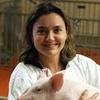Explore all the information on
Swine biosecurity
Biosecurity of pigs at the farm level is the set of practical measures taken to prevent entrance of infection into a pig farm and control the spread of infection within that farm. The goal of a biosecurity program is to keep out pathogens that the herd has not been exposed to and to minimize the impact of endemic pathogens. Pig farm security can be defined as the planning and implementation of a program to minimize various types of risk that can have detrimental effects on the farmstead and pigs. Biosecurity and security procedures are intertwined to enhance the health and productivity of pigs. Numerous factors are involved in the development and maintenance of a cost-effective program for biosecurity. These factors can be thought of as links in a chain; a biosecurity program is only as strong as its weakest link.
ll farm biosecurity and security risk factors are unique to that farm and, thus, each biosecurity plan should be farm specific. The best plans are created by working with a swine veterinarian or veterinary consultant who has extensive knowledge of the farm, employees, and local risk factors.
The application of biosecurity measures differs among farms due to the geographic location of the farm, proximity to other pig farms, epidemiological situation (causes, distribution, and control of disease in the herd), type of swine operation, level of technology used for production, and whether other people are employed on the farm.
Comments related to #Swine biosecurity
Top 10 content about #Swine biosecurity




















